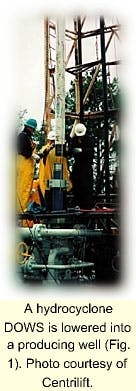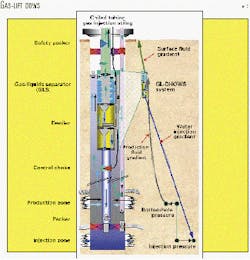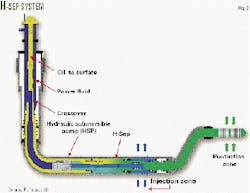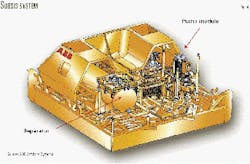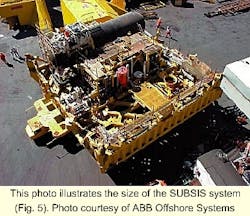As oil prices have increased, interest in downhole oil-water separators (DOWS) has returned after a 2-year lull caused by a low oil price and the nervousness of operators to install relatively unproven technology, which in many trials had proven uneconomical.
DOWS technology aims to reduce produced water at the surface by separating it from oil downhole and simultaneously injecting it underground. The technology holds great promise for reducing produced-water disposal costs and protecting potable-water aquifers. It has, in some instances, increased oil production from wells in which it has been installed.
During the last 2 years, some DOWS vendors have ceased actively marketing their DOWS technology for the time being. On the other hand, oil companies around the world are again seriously considering ordering or testing DOWS technology in 2001.
The first offshore installation of a DOWS took place off China during 2000. Other offshore trials may follow this year.
Several new variations on DOWS and remote separation systems offer potential for different market segments, and 2001 should be a more promising year for DOWS.
DOWS technology
A DOWS system includes many components, but the two primary ones are an oil-water separation system and at least one pump to lift oil to surface and inject water downhole.
Two basic types of DOWS have been developed. One uses hydrocyclones mechanically to separate oil and water; the other relies on gravity separation in the wellbore.1-3
Hydrocyclones have no moving parts and use centrifugal force to separate fluids with different specific gravities. In the process, an oil and water mixture enters the hydrocyclone at high speed from the side of a conical chamber.
The subsequent swirling action causes the heavier water to move to the outside of the chamber and exit through one end, while the lighter oil remains in the interior of the chamber and exits through a second opening.
The water fraction is then injected downhole and the oil fraction is pumped to the surface.
A hydrocyclone DOWS can be combined with an electric submersible pump, progressing cavity pump, or sucker-rod pump. C-FER Technologies Inc., Edmonton, has done most of the development work on these designs through several joint-industry projects.
A hydrocyclone DOWS is lowered into a producing well (Fig. 1). Photo courtesy of Centrilift.
Fig. 1 shows a hydrocyclone DOWS being lowered into a well.
A gravity-separator DOWS allows oil droplets that enter a wellbore to rise and form a discrete oil layer in the well. This DOWS has two intakes: one in the oil layer and the other in the water layer.
As sucker rods travel up and down, the oil is lifted to the surface and the water is injected. Texaco Inc. developed the most common gravity-separator DOWS, which is a dual-action pumping system (DAPS).
An improved version that develops greater injection pressure, the triple-action pumping system (TAPS), also has been tested.4 TAPS achieves greater injection pressure by adding a third bottom plunger with a smaller surface area than the middle plunger.
Reasons for DOWS
Produced-water lifting, treatment, and disposal costs are important components of operating costs. A DOWS can save operators money by reducing these costs.
DOWS installations reduced water volume brought to the surface in 29 of the cases examined in a study.1 The reduction ranged from 14 to 97%, with most installations exceeding a 75% reduction in water brought to the surface.
In more than half of the North American wells in which DOWS have been installed, the oil production rates increased following installation. The increased oil production rates ranged from 11 to more than 1,100%, although oil production decreased in a few wells.1
In some cases in which surface processing or disposal capacity is a limiting factor for further production within a field, use of a DOWS to dispose some produced water may allow additional production in that field.
A DOWS provides a positive but not quantifiable environmental benefit by minimizing the opportunity for underground sources of potable water to become contaminated through tubing and casing leaks during the injection process. Likewise, DOWS installations minimize spillage of produced water onto the soil at the surface because less produced water is handled at the surface.
Economic considerations
Nearly all DOWS installations to date have been made as retrofits to existing wells with standard pumps. Conversion of a well from a regular pump to DOWS technology is a relatively expensive undertaking, including both the cost of the DOWS and well workover expenses. Reference 1 provides some information on costs, but many operators polled by the authors did not provide detailed cost information.
Hydrocyclone DOWS units are expensive. For example, installation of an electric submersible pump DOWS system costs about two to three times more than the replacement of a conventional electrical submersible pump.
The expense often ranges from $90,000 to $250,000, excluding the workover costs. Workover costs can often exceed $100,000.
Gravity separator DOWS cost less, ranging from $15,000 to $25,000. One example of a complete installation of this type cost $140,000 (Can.).1
Early trials
Fewer than 100 DOWS have been installed worldwide. Reference 1 discusses the geology and performance of 37 of these installations.
In these installations, oil production increased in 19, decreased in 12, remained the same in 2, and was unspecified in 4.
The top three performing wells with hydrocyclone DOWS had oil production increases of 457-1,162%, while in one well, oil production decreased. In the top performing well, oil production increased to 164 b/d from 13 b/d.
The top three gravity-separator DOWS installations showed oil production increases of 106-233%, while in one well, production decreased. In the top performing well, oil production increased to 10 b/d from 3 b/d.
In the 29 trials for which both preinstallation and postinstallation water production data were available, water volume brought to the surface decreased. Water volumes decreased from 14 to 97%, with 22 of the 29 trials exceeding a 75% reduction.
Problems experienced
Despite success in the early trials, numerous other installations either did not work well from the start or declined in performance within a few weeks or months. These DOWS systems needed to be removed from the well and repaired.
Some failures resulted from improper selection and design of the installation because some operators didn't want to risk damaging good performing wells with a new device, and therefore, they selected less-than-optimal candidate wells.
Also, particularly in the earliest installations, many design flaws had not been worked out. For example, valves failed and narrow-diameter transfer tubes or electrical cables became crimped or broken during installation. Subsequent models avoided some of these pitfalls.
Other failures resulted from an insufficient distance between the producing and the injection interval, which allowed the injected fluid to migrate into the producing zone. This led to recycling the produced water and producing almost no oil.
At two installations, incompatible injected fluids contacted sensitive reservoir sands, reducing permeability and injectivity.
Several installations suffered from corrosion or scaling because of incompatible chemistry between the produced and injected fluids.
Several other installations experienced problems with excessive sand production that either clogged the formation or eroded the DOWS components.
DOWS status
In 1999, three companies that actively marketed DOWS equipment in the US were Centrilift (a unit of Baker Oil Tools), Reda (a unit of Schlumberger Oilfield Services), and Halliburton Energy Services. During 2000, only Centrilift continued actively to market the technology.
Reda plans further research and development but no active marketing of DOWS technology until it believes that at least 80% of installations will be economical.5
Likewise, Halliburton has not actively marketed its DOWS tools during the past year and does not anticipate expanding its marketing efforts in the near future.6
In Canada, Quinn Pumps (a unit of Quinn's Oilfield Supply Ltd., Red Deer, Alta.) marketed several DOWS systems but has not installed any during the past 2 years, although it hopes to have new installations in 2001.7
Texaco was a leader in developing gravity-separator DOWS technology. During the past 2 years, however, Texaco disbanded its core group of DOWS researchers, with some retiring and others being reassigned to different projects. One Texaco well was sold, and its DOWS system was removed from the well.
Centrilift has five active installations. These are in the US, Argentina, France, and off China.
The Chinese installation was the first offshore trial of DOWS technology. This system was successfully installed and started, but analysis indicated that injected water had recirculated into the producing zone.
After operating for 3 weeks, the DOWS was pulled from the well and inspected on surface. Centrilift found that a simple field service error had occurred. Additionally, review of the sensor data from downhole revealed that both the productivity and injectivity indices had been optimistically forecast.
The DOWS is being redesigned, reassembled, and tested before reinstallation in the first quarter of 2001.8
On a brighter note, Centrilift's US installation has been running for 36 months (with the current equipment at 20 months), and the French installation has done even better-a 25-month run time.
The French installation operates somewhat differently than other DOWS systems. In this installation, the oil and water are separated downhole, but both streams are brought separately to the surface. The water stream is then reinjected.9
It is interesting to note that although the use of DOWS technology started in North America, many of the new installations and probably many of the installations in the next 1 or 2 years will be in other parts of the world.
Some areas, other than those previously mentioned, which may see DOWS installations in the next 2 years, are in Europe, South America, Asia, Australia, and the Middle East.
Argonne sponsorship
In 1998, the US Department of Energy (DOE) transferred funds to Argonne National Laboratory to be shared with operators to partially defray the cost of several DOWS installations. In exchange for the DOE funds, operators were to provide performance details on the well for 6 months following installation.
Argonne has had poor success in distributing this federal funding. Through December 2000, only one company was interested enough to complete a cofunded field trial, a TAPS installation on a Texaco well in New Mexico. References 10 and 11 detail the results of this trial.
In fall 2000, Argonne signed a contract with Avalon Exploration Inc., an Oklahoma-based independent producer, to cofund a DOWS installation in Oklahoma. The installation had been scheduled for November 2000, but because of drilling rig availability problems, the installation date was moved to February 2001.
The test includes a hydrocyclone DOWS installed in a new well, unlike previous installations which mostly involved retrofits of old wells. A report on this installation should be available in 2002.
In late 1998, a large US producer in stalled a DOWS system in a well near Van, Tex. The performance data from this well have never been made public, but Argonne and the producer have signed an agreement giving Argonne access to the DOWS performance data in exchange for analyzing the data.
As of January 2001, a draft data-analysis report was undergoing review, and Argonne hopes to publish a report during 2001.
In 1999, DOE awarded a large grant to Venoco Inc., Santa Barbara, Calif., a southern California offshore producer, to conduct a pilot application using a DOWS unit attached to an electric submersible pump. The goal was to improve field economics and minimize water disposal in the South Ellwood field, offshore Santa Barbara, Calif.
As of December 2000, Venoco reported that the first phase of the project, reservoir and fracture characterization, was under way. It may install the DOWS unit in mid-2002.12
New technology
Over the past 2 years, several other companies have introduced DOWS units or related equipment. Wood Group ESP Inc. has developed a two-stage hydrocyclone DOWS system but has not yet actively marketed the product.
One unit underwent a surface test in Venezuela but has not yet been installed in a well. A field trial is scheduled for 2001. According to a representative of the company, its DOWS requires a larger-diameter casing to accommodate the unit, but it is easier to install than some other types of DOWS systems.13
C-FER Technologies has worked with PanCanadian Petroleum Ltd., Calgary, to develop and test a new class of hydrocyclone DOWS devices that operate with gas lift systems (Fig. 2). This technology has strong implications for offshore wells.
The first stage of the system separates free gas from the oil and water stream. In the second stage, a hydrocyclone separates the oil and water. The oil is commingled with separated free gas and lifted to the surface, and the water is injected.
The system is designed to process about 2,500 b/d in 7-in. casing and about 15,000 b/d in 95/8-in. casing. The design operating conditions are greater than 85% water cut and up to 85% free gas.14
C-FER has built and tested a full-scale prototype of the system and is now evaluating candidates for a field trial. A recent industry journal provides a diagram and brief description of the tool.15
Three European companies, Weir Norge AS, Kvaerner Oilfield Products Norway, and Norsk Hydro AS, have collaborated to develop a new class of gravity-separation DOWS called H-SEP (Fig. 3). The design allows gravity separation to occur in the horizontal section of an extended reach well.
The downhole conditions allow for rapid separation of oil and water. Oil is lifted to the surface, while water is injected by an hydraulic submersible pump, powered by either water or oil. The hydraulic submersible pump can produce more than enough pressure to fracture the rock in the injection formation.
The H-SEP has been pilot-tested at a surface testing facility in Norway and is scheduled for a full-scale field demonstration in an offshore well during 2001.
The H-SEP developers claim that the technology can work across the entire spectrum of water cuts (1% to more than 90% water), whereas most of the other DOWS systems work well only when the water cut is high.16 This feature allows the H-SEP to be installed in new wells.
The final new technology discussed is not a DOWS, but it involves remote oil-water separation nonetheless. ABB Offshore Systems developed a subsea separation and injection system (SUBSIS) that separates the produced fluids from an offshore well at a treatment module on the seafloor (Fig. 4). Because size is not limited to the dimensions of a wellbore, SUBSIS is much larger than the DOWS tools previously described.
The first pilot unit weighs 350 tons and has two modules: a 10-m long by 3-m diameter separator module and a 5-m high injection and pumping module (Fig. 5). This pilot device was installed during May 2000 at Norsk Hydro's operated Troll field in 350-m water.
The initial results indicated that 23,900 b/d of produced fluids were separated into 16,350 b/d of oil and gas and 7,550 b/d of water. The water was injected into a dedicated injection well directly from the SUBSIS unit.17 18
The last comment on the future of DOWS technology is not a specific technology per se, but an innovative approach to recover more oil from a field in a shorter amount of time. The so-called π-mode production strategy relies heavily on the use of downhole oil-water separators to reinject water into the same formations from which the fluids originated in order to maintain formation pressure.19
This process aims to accelerate the rate of recovering the available oil.
Acknowledgments
The Argonne National Laboratory study on DOWS was supported by the US Department of Energy, Office of Fossil Energy, National Petroleum Technology Office (NPTO), under contract W-31-109-Eng-38. Nancy Comstock is the NPTO project officer for the DOWS projects and her help is appreciated.
Throughout this article, companies or organizations that have developed DOWS technology or are currently suppliers of DOWS technology are mentioned by name. Reference to these companies does not constitute an endorsement of those companies or provide any indication of their performance capabilities.
Inclusion of their names is made for historical reference and for the benefit of potential users of the technology. Omission of any other legitimate vendors of DOWS technology is unintentional.
References
1. Veil, J.A., Langhus, B.G., and Belieu, S., Feasibility Evaluation of Downhole Oil/Water Separation (DOWS) Technology, prepared for US DOE Office of Fossil Energy, National Petroleum Technology Office, by Argonne National Laboratory, CH2M-Hill, and Nebraska Oil and Gas Conservation Commission, January 1999.
2. Veil, J.A, Langhus, B.G., and Belieu, S., "Downhole Oil/Water Separators: An Emerging Produced Water Disposal Technology," SPE Paper No. 52703, SPE/EPA Exploration and Production Environmental Conference, Austin, Feb. 28-Mar. 3, 1999.
3. Veil, J.A., Langhus, B.G., and Belieu, S., "DOWS reduce produced water disposal Costs," OGJ, Mar. 22, 1999, p. 76.
4. Wacker, H.J., Parker, R.M., Stuebinger, L., Harding, R., and Watson, B., "Test proves out triple-action pump in downhole separation," OGJ, Vol. 97, No. 40, Oct. 4. 1999, pp. 49-55.
5. Schrenkel, P., Reda Pump, personal communication with J. Veil, Dec. 14, 2000.
6. Watson, B., Halliburton, personal communication with J. Veil, Jan. 3, 2001,
7. Collins, R., Quinn's Oilfield Supply Ltd., personal communication with J. Veil, Dec. 14, 2000.
8. Shaw, C., Centrilift, personal communication with J. Veil, Dec. 27, 2000.
9. Voss, D., Centrilift, personal communication with J. Veil, Dec. 12, 2000.
10. Veil, J.A., Summary of Data from DOE-Subsidized Field Trial No. 1 of Downhole Oil/Water Separator Technology-Texaco Well Bilbrey 30-Federal No. 5, Lea County, New Mexico, prepared for US DOE National Petroleum Technology Office, May 2000.
11. Veil, J.A., "Downhole Oil/Water Separators-What's New?" Produced Water Seminar, Houston, Jan. 19-21, 2000.
12. Christensen, K., Venoco Inc., personal communication with J. Veil, Dec. 8, 2000.
13. Barry, M., Wood Group ESP Inc. personal communication with J. Veil, Dec. 8, 2000.
14. Alhanati, F., C-FER Technologies Inc., personal communication with J. Veil, Dec. 15, 2000.
15. "Technology Applications," JPT, December 2000, p. 16.
16. Almdahl, P.M., Gunneroed, T., Gramme, P., and Olsen, G.I., "Downhole Horizontal Separation (H-Sep)-An Alternative Downhole Oil/Water Separation (DOWS) Technology," 12th Annual Deep Offshore Technology Conference, New Orleans, Nov. 7-9, 2000.
17. "ABB Looking to Progress Subsea Processing into Ultra-Deepwater," Offshore, Vol. 60, No. 8, August 2000.
18. Wolff, E.A., "Reduction of Emissions to Sea by Improved Produced Water Treatment and Subsea Separation Systems," SPE Paper No. 61182, SPE International Conference on Health, Safety, and Environment, Stavanger, June 26-28. 2000.
19. Ehlig-Economides, C., and Economides, M., "Oil Recovery Could Be Accelerated using π-Mode Production Strategy," World Oil, November 2000, pp. 53-56,
The author
John A. Veil is manager of the water policy program for Argonne National Laboratory in Washington, DC. He analyzes a variety of water and waste issues affecting the oil and gas industry for the US Department of Energy. Veil has a BA in earth and planetary science from Johns Hopkins University and two MS degrees, in zoology and in civil engineering, from the University of Maryland.
Based on a presentation to the Produced Water Seminar, Houston, Jan. 17-19, 2001.
